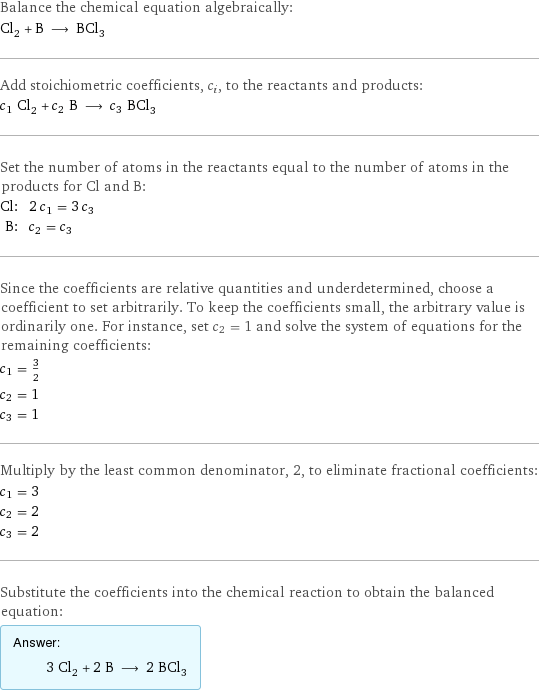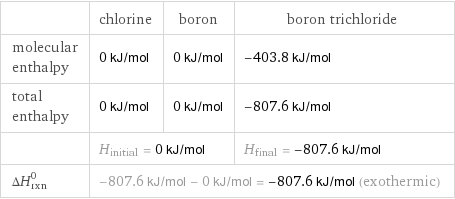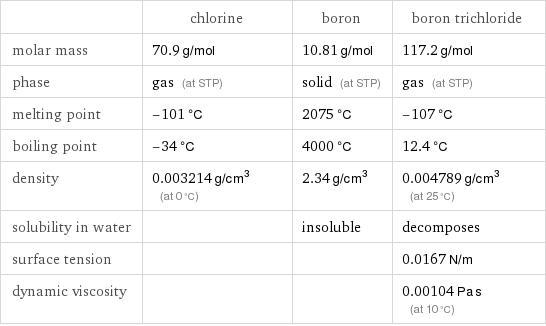Input interpretation

Cl_2 chlorine + B boron ⟶ BCl_3 boron trichloride
Balanced equation

Balance the chemical equation algebraically: Cl_2 + B ⟶ BCl_3 Add stoichiometric coefficients, c_i, to the reactants and products: c_1 Cl_2 + c_2 B ⟶ c_3 BCl_3 Set the number of atoms in the reactants equal to the number of atoms in the products for Cl and B: Cl: | 2 c_1 = 3 c_3 B: | c_2 = c_3 Since the coefficients are relative quantities and underdetermined, choose a coefficient to set arbitrarily. To keep the coefficients small, the arbitrary value is ordinarily one. For instance, set c_2 = 1 and solve the system of equations for the remaining coefficients: c_1 = 3/2 c_2 = 1 c_3 = 1 Multiply by the least common denominator, 2, to eliminate fractional coefficients: c_1 = 3 c_2 = 2 c_3 = 2 Substitute the coefficients into the chemical reaction to obtain the balanced equation: Answer: | | 3 Cl_2 + 2 B ⟶ 2 BCl_3
Structures

+ ⟶
Names

chlorine + boron ⟶ boron trichloride
Reaction thermodynamics
Enthalpy

| chlorine | boron | boron trichloride molecular enthalpy | 0 kJ/mol | 0 kJ/mol | -403.8 kJ/mol total enthalpy | 0 kJ/mol | 0 kJ/mol | -807.6 kJ/mol | H_initial = 0 kJ/mol | | H_final = -807.6 kJ/mol ΔH_rxn^0 | -807.6 kJ/mol - 0 kJ/mol = -807.6 kJ/mol (exothermic) | |
Equilibrium constant
![Construct the equilibrium constant, K, expression for: Cl_2 + B ⟶ BCl_3 Plan: • Balance the chemical equation. • Determine the stoichiometric numbers. • Assemble the activity expression for each chemical species. • Use the activity expressions to build the equilibrium constant expression. Write the balanced chemical equation: 3 Cl_2 + 2 B ⟶ 2 BCl_3 Assign stoichiometric numbers, ν_i, using the stoichiometric coefficients, c_i, from the balanced chemical equation in the following manner: ν_i = -c_i for reactants and ν_i = c_i for products: chemical species | c_i | ν_i Cl_2 | 3 | -3 B | 2 | -2 BCl_3 | 2 | 2 Assemble the activity expressions accounting for the state of matter and ν_i: chemical species | c_i | ν_i | activity expression Cl_2 | 3 | -3 | ([Cl2])^(-3) B | 2 | -2 | ([B])^(-2) BCl_3 | 2 | 2 | ([BCl3])^2 The equilibrium constant symbol in the concentration basis is: K_c Mulitply the activity expressions to arrive at the K_c expression: Answer: | | K_c = ([Cl2])^(-3) ([B])^(-2) ([BCl3])^2 = ([BCl3])^2/(([Cl2])^3 ([B])^2)](../image_source/880b5223ceddbff1c4fd6c3de18ab5a3.png)
Construct the equilibrium constant, K, expression for: Cl_2 + B ⟶ BCl_3 Plan: • Balance the chemical equation. • Determine the stoichiometric numbers. • Assemble the activity expression for each chemical species. • Use the activity expressions to build the equilibrium constant expression. Write the balanced chemical equation: 3 Cl_2 + 2 B ⟶ 2 BCl_3 Assign stoichiometric numbers, ν_i, using the stoichiometric coefficients, c_i, from the balanced chemical equation in the following manner: ν_i = -c_i for reactants and ν_i = c_i for products: chemical species | c_i | ν_i Cl_2 | 3 | -3 B | 2 | -2 BCl_3 | 2 | 2 Assemble the activity expressions accounting for the state of matter and ν_i: chemical species | c_i | ν_i | activity expression Cl_2 | 3 | -3 | ([Cl2])^(-3) B | 2 | -2 | ([B])^(-2) BCl_3 | 2 | 2 | ([BCl3])^2 The equilibrium constant symbol in the concentration basis is: K_c Mulitply the activity expressions to arrive at the K_c expression: Answer: | | K_c = ([Cl2])^(-3) ([B])^(-2) ([BCl3])^2 = ([BCl3])^2/(([Cl2])^3 ([B])^2)
Rate of reaction
![Construct the rate of reaction expression for: Cl_2 + B ⟶ BCl_3 Plan: • Balance the chemical equation. • Determine the stoichiometric numbers. • Assemble the rate term for each chemical species. • Write the rate of reaction expression. Write the balanced chemical equation: 3 Cl_2 + 2 B ⟶ 2 BCl_3 Assign stoichiometric numbers, ν_i, using the stoichiometric coefficients, c_i, from the balanced chemical equation in the following manner: ν_i = -c_i for reactants and ν_i = c_i for products: chemical species | c_i | ν_i Cl_2 | 3 | -3 B | 2 | -2 BCl_3 | 2 | 2 The rate term for each chemical species, B_i, is 1/ν_i(Δ[B_i])/(Δt) where [B_i] is the amount concentration and t is time: chemical species | c_i | ν_i | rate term Cl_2 | 3 | -3 | -1/3 (Δ[Cl2])/(Δt) B | 2 | -2 | -1/2 (Δ[B])/(Δt) BCl_3 | 2 | 2 | 1/2 (Δ[BCl3])/(Δt) (for infinitesimal rate of change, replace Δ with d) Set the rate terms equal to each other to arrive at the rate expression: Answer: | | rate = -1/3 (Δ[Cl2])/(Δt) = -1/2 (Δ[B])/(Δt) = 1/2 (Δ[BCl3])/(Δt) (assuming constant volume and no accumulation of intermediates or side products)](../image_source/7c7f0c61a28541f402b1650b714799b3.png)
Construct the rate of reaction expression for: Cl_2 + B ⟶ BCl_3 Plan: • Balance the chemical equation. • Determine the stoichiometric numbers. • Assemble the rate term for each chemical species. • Write the rate of reaction expression. Write the balanced chemical equation: 3 Cl_2 + 2 B ⟶ 2 BCl_3 Assign stoichiometric numbers, ν_i, using the stoichiometric coefficients, c_i, from the balanced chemical equation in the following manner: ν_i = -c_i for reactants and ν_i = c_i for products: chemical species | c_i | ν_i Cl_2 | 3 | -3 B | 2 | -2 BCl_3 | 2 | 2 The rate term for each chemical species, B_i, is 1/ν_i(Δ[B_i])/(Δt) where [B_i] is the amount concentration and t is time: chemical species | c_i | ν_i | rate term Cl_2 | 3 | -3 | -1/3 (Δ[Cl2])/(Δt) B | 2 | -2 | -1/2 (Δ[B])/(Δt) BCl_3 | 2 | 2 | 1/2 (Δ[BCl3])/(Δt) (for infinitesimal rate of change, replace Δ with d) Set the rate terms equal to each other to arrive at the rate expression: Answer: | | rate = -1/3 (Δ[Cl2])/(Δt) = -1/2 (Δ[B])/(Δt) = 1/2 (Δ[BCl3])/(Δt) (assuming constant volume and no accumulation of intermediates or side products)
Chemical names and formulas

| chlorine | boron | boron trichloride formula | Cl_2 | B | BCl_3 name | chlorine | boron | boron trichloride IUPAC name | molecular chlorine | boron | trichloroborane
Substance properties

| chlorine | boron | boron trichloride molar mass | 70.9 g/mol | 10.81 g/mol | 117.2 g/mol phase | gas (at STP) | solid (at STP) | gas (at STP) melting point | -101 °C | 2075 °C | -107 °C boiling point | -34 °C | 4000 °C | 12.4 °C density | 0.003214 g/cm^3 (at 0 °C) | 2.34 g/cm^3 | 0.004789 g/cm^3 (at 25 °C) solubility in water | | insoluble | decomposes surface tension | | | 0.0167 N/m dynamic viscosity | | | 0.00104 Pa s (at 10 °C)
Units
